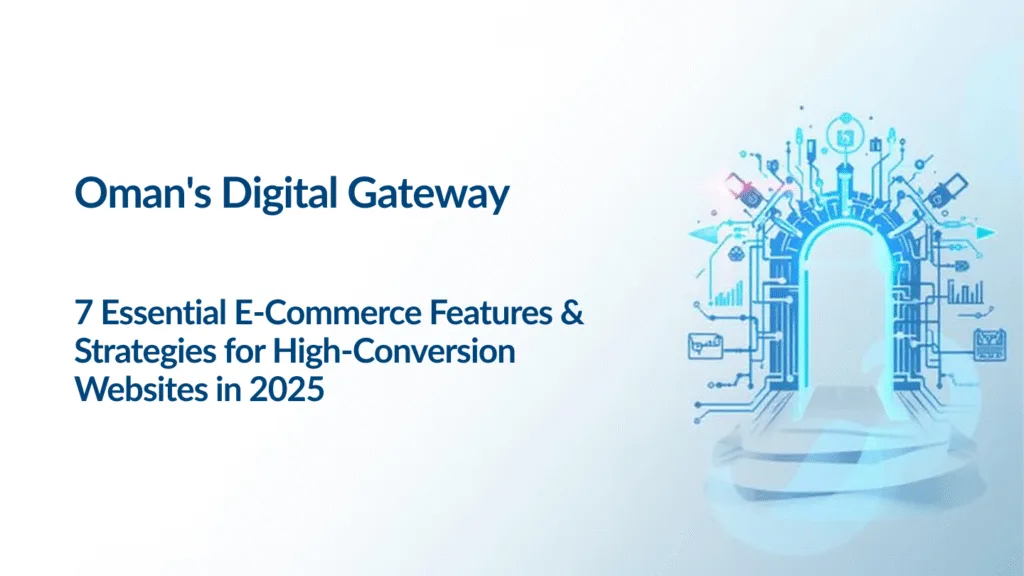The Sultanate of Oman is not merely witnessing a digital evolution; it is undergoing a revolution. Driven by ambitious government mandates under Oman Vision 2040 and a highly connected, youthful population, the local e-commerce market is set on a trajectory of robust growth, with a projected Compound Annual Growth Rate (CAGR) exceeding 13.5% through 2030. For businesses—both local and international—aiming to thrive in this burgeoning landscape, merely establishing an online presence is insufficient. Success hinges on integrating a specific set of high-conversion features tailored precisely to the behaviors, preferences, and regulatory environment of the Omani consumer.
This article, structured as an expert guide, delves into the essential features and strategies that will ensure your e-commerce website not only gains high visibility through SEO but also converts browsing visitors into loyal customers in the highly competitive Omani digital space.
1. Mobile-First Supremacy: The M-Commerce Mandate
SEO & Conversion Focus: Site Speed and Mobile UX
Oman boasts one of the highest smartphone penetration rates globally, and the majority of online shopping transactions—well over 80%—occur via mobile devices. This makes Mobile Commerce (M-Commerce) the primary channel for sales. Google’s commitment to mobile-first indexing dictates that your website’s performance on a phone is paramount to your SEO ranking.
Essential Features:
- Progressive Web App (PWA) Functionality: Move beyond a simple responsive design. A PWA allows your website to function like a native application—offering ultra-fast loading times, offline browsing capability, and the use of push notifications—without requiring an app store download. This dramatically reduces friction and improves user retention.
- Intuitive Mobile Navigation: Design with the “fat finger” principle in mind. Ensure large, easily clickable buttons, single-column product layouts, and a persistently visible shopping cart icon.
- Accelerated Mobile Pages (AMP) / Core Web Vitals: Focus aggressively on optimizing for Google’s Core Web Vitals (especially Largest Contentful Paint – LCP) to guarantee load speeds of under 2 seconds, which is a non-negotiable factor for both modern SEO and user engagement.
Good to Know: The high dependency on mobile devices means developers must prioritize code efficiency and image optimization tailored for high-speed, yet potentially intermittent, mobile broadband connections.
2. Hyper-Localized Payment & Trust Infrastructure
SEO & Conversion Focus: Payment Friction Reduction and Local Trust
While global payment trends are accelerating, the Omani market still demands a blend of international security standards and local comfort. The payment stage is where most trust signals are processed.
Essential Features:
- Local Payment Gateway Integration: Beyond Visa and MasterCard, your site must integrate seamlessly with prominent local and regional financial technologies. This includes supporting:
- OmanNet: The national payment switch, vital for connecting to local bank accounts.
- Thawani: A leading Omani e-payment platform known for its security and convenience.
- Bank Muscat’s E-Payment Solutions: Integration with solutions from major local banks strengthens customer familiarity.
- Mandatory Cash-on-Delivery (COD): Despite the growth of mobile wallets (which are growing at nearly 15% CAGR), a significant portion of the population, particularly for initial purchases or higher-ticket items, still relies on COD. Offering this option, especially for last-mile logistics, is critical for market penetration.
- Omani Rial (OMR) as Default Currency: All product pricing must be clearly and unambiguously displayed in OMR. While multi-currency options are welcome, the local currency is the foundational requirement for transaction confidence.
- Buy Now, Pay Later (BNPL) Options: The adoption of BNPL is accelerating for major purchases (electronics, furniture). Offering this flexibility can significantly increase your Average Order Value (AOV) and reduce immediate price sensitivity.
3. Official Verification & Regulatory Transparency
SEO & Conversion Focus: Authority and Legal Compliance
The Omani government is actively regulating the e-commerce sector to build consumer trust and eliminate fraud. Compliance is no longer optional; it is a prerequisite for long-term brand credibility and SEO authority.
Essential Features:
- Maroof Oman Verification: The Ministry of Commerce, Industry and Investment Promotion (MoCIIP) requires all legitimate online businesses to register and secure verification through the national platform, Maroof Oman. Prominently displaying the Maroof badge is a powerful local trust signal that sets your business apart.
- Compliance with Electronic Transactions Law: Your legal documentation must align with the Sultanate’s regulations, including the new Electronic Transactions Law. Clear, easy-to-find pages for Terms and Conditions, Privacy Policy, and Refund/Exchange Policies are essential.
- Transparent Returns and Exchanges: Omani shoppers expect clear, simple, and reliable return processes. Given the preference for tangibility, especially in Fashion and Apparel (the largest e-commerce segment), an easy returns process is a significant conversion factor.
4. Bilingual SEO and Arabic Content Strategy
SEO & Conversion Focus: Search Ranking and User Engagement
To capture the entire Omani search market, a bilingual SEO strategy is essential. While English is widely used, the native Arabic-speaking population is a massive, often underserved segment.
Essential Features:
- Comprehensive Arabic Interface: The Arabic version must be a true translation, not just of main pages but of every product description, review, and FAQ section. Use a clear Arabic/English language toggle.
- Hreflang Implementation: Correctly using the hreflang attribute (ar-om and en-om) signals to Google which content version to serve to users in Oman, preventing duplicate content penalties and boosting regional search accuracy.
- Conversational Voice Search Optimization: With the rise of voice assistants, optimize your content for conversational, long-tail keywords in both languages (e.g., “Where can I buy [Product] in Muscat?” in Arabic).
- Localized Influencer Content: Partner with local Omani micro-influencers on platforms like Instagram and TikTok, integrating their authentic, short-form video content to create trust and drive traffic from social media.
5. Intelligent Logistics and Delivery Transparency
Conversion Focus: Reliability and Last-Mile Service
Logistics excellence is a primary competitive advantage. Omani consumers, especially those in densely populated areas like Muscat, increasingly demand speed and guaranteed delivery times.
Essential Features:
- Real-Time Tracking (R.T.T.): Provide end-to-end, real-time order tracking visible on your website. This reduces customer support load and significantly enhances trust by creating delivery transparency.
- Flexible Delivery Slots: Integrate with local logistics partners like Asyad Express or other reliable regional couriers to offer customers the option to select specific delivery time windows or choose automated pickup lockers for greater convenience.
- Geographic Differentiation: Implement a system to automatically offer same-day or 24-hour delivery within key urban zones (Muscat, Sohar, Salalah) while managing expectations and pricing for interior governorates.
- Returns Logistics Management: Ensure a clear, efficient reverse logistics process. The ability to schedule a hassle-free courier pickup for a return is a major factor in customer satisfaction.
6. Personalization and Conversational Commerce
SEO & Conversion Focus: Data-Driven Retention and UX
Personalization transforms a transactional website into a relationship-building platform, which translates to high customer lifetime value (CLV) and repeat purchases.
Essential Features:
- AI-Driven Product Recommendations: Use machine learning to analyze browsing history and purchase patterns, offering tailored product suggestions like “Customers who bought this also viewed…” or “Personalized for you” sections.
- WhatsApp Business Customer Support: Leverage the popularity of WhatsApp in the MENA region. Integrate a WhatsApp button for instant, conversational customer service, allowing agents to respond quickly to pre-sale inquiries and post-purchase issues.
- Loyalty & Rewards Program: Implement a simple, tiered rewards system that offers points or discounts redeemable on the local currency. This incentivizes repeat purchases and boosts conversion rates.
7. Future-Proofing: B2B and High-Growth Categories
SEO & Conversion Focus: Targeting Emerging Market Segments
While the B2C segment (led by Fashion and Apparel) dominates, the market is quickly diversifying. Future success requires features that capture emerging growth areas.
Essential Features for B2B Readiness:
- B2B Accounts & Bulk Pricing: Given that the B2B segment is forecast to expand significantly (estimated to represent 40% of the market by 2028), your platform should support multi-user B2B accounts, customized invoicing, and automated bulk pricing tiers.
- Grocery & FMCG Features: The Food and Beverages/FMCG category is one of the fastest-growing. Essential features here include subscription models for recurring purchases, temperature-controlled logistics integrations, and simplified list-based ordering.
- Rich Media Product Visualization: Leverage trends like Augmented Reality (AR)—allowing a customer to virtually place furniture in their home or virtually “try on” clothing—to reduce uncertainty and drive conversions, particularly in the growing Home Furnishing and Apparel sectors.
The Final Verdict: Seizing the Omani Digital Opportunity
The Omani e-commerce market is in a prime acceleration phase. The businesses that will capture market share are those that move beyond generic e-commerce templates and strategically implement features that address local pain points—namely, trust, delivery speed, and payment flexibility. By prioritizing M-Commerce, securing Maroof Oman verification, and optimizing your platform for seamless Arabic/English SEO, you can future-proof your business and position yourself as a leader in the Sultanate’s vibrant digital economy. The time to invest in localization and advanced digital features is now.






